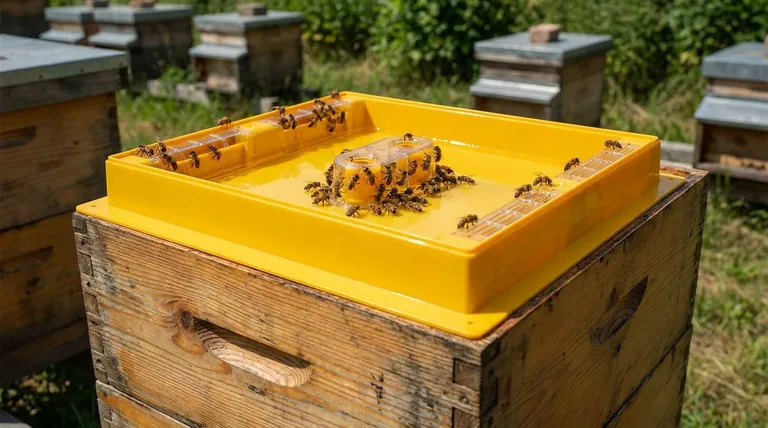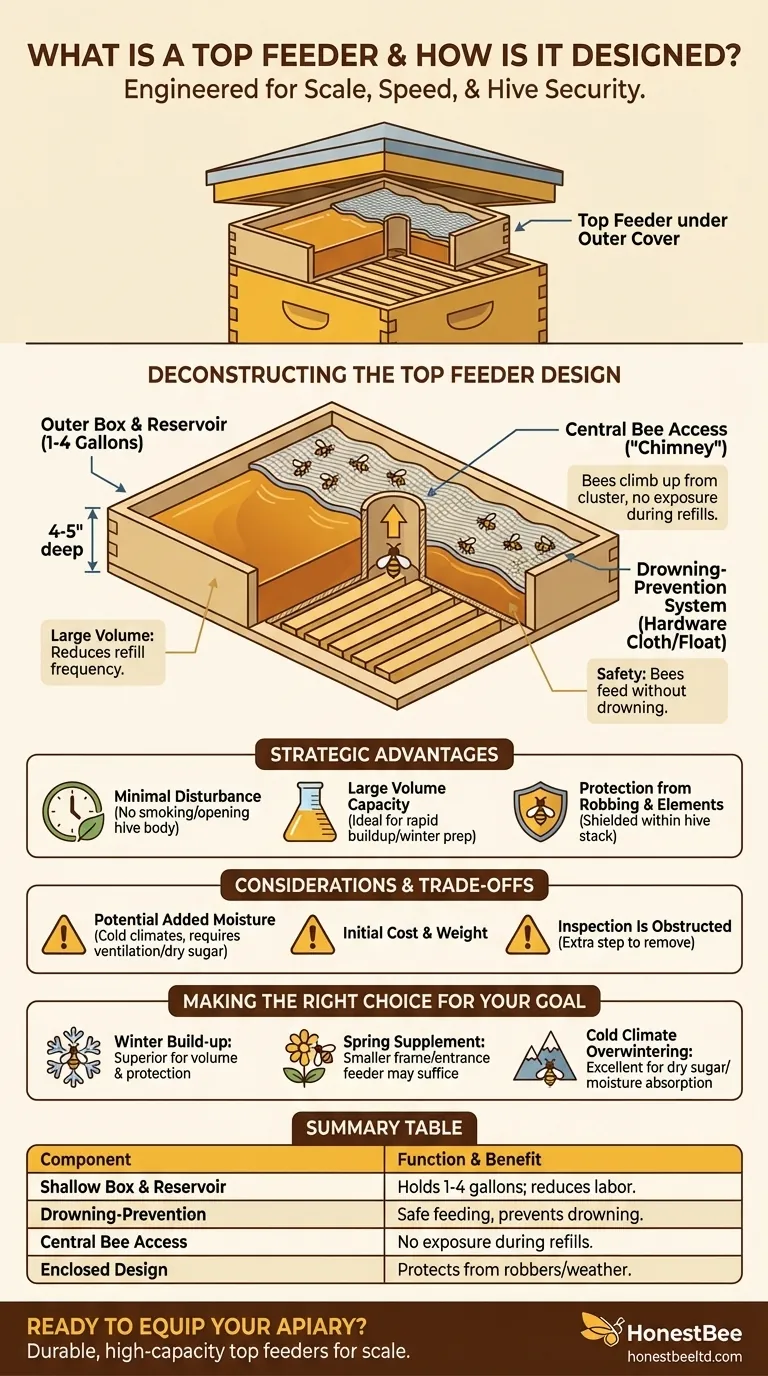At its core, a top feeder is a self-contained feeding station placed on the very top of a beehive, directly under the outer cover. Its design consists of a shallow box, sized to fit standard 8-frame or 10-frame Langstroth hives, which houses a large reservoir for syrup. Critically, it includes a built-in mechanism, typically hardware cloth or a screened-off section, that allows bees to access the food without the risk of drowning.
The true purpose of a top feeder's design is to enable beekeepers to deliver large quantities of food with maximum efficiency and minimal disturbance to the colony. It is a tool engineered for scale, speed, and hive security.

Deconstructing the Top Feeder Design
To understand why top feeders are so effective, you must first appreciate the specific problems each design element solves.
The Outer Box and Reservoir
The main body of the feeder is a shallow box, typically 4 to 5 inches deep, that sits on the hive like another super. This enclosure contains a plastic or wood-sealed reservoir that can hold one to four gallons of syrup.
This large volume is a key strategic advantage, reducing the frequency of refills and the labor required to maintain the apiary.
The Drowning-Prevention System
The most critical design feature is the system that separates the bees from the bulk of the syrup. This is usually a section of hardware cloth or a specially molded plastic float or ladder system.
Bees can walk on this surface and drink the syrup that wells up through it, but they are physically prevented from falling into the main reservoir and drowning. This solves one of the biggest problems associated with open feeding inside a hive.
Central Bee Access
Most designs incorporate a central "chimney" or open space that aligns with the frames below. The bees climb up from their cluster through this opening and into the protected feeding area.
When you need to refill the feeder, you can pour syrup into the reservoir without ever exposing this central access point, meaning the bees remain safely inside the hive.
The Strategic Advantages of Feeding from Above
The design of a top feeder directly translates into several major operational benefits for the beekeeper.
Minimal Hive Disturbance
Because the feeder can be refilled without opening the main hive body, the colony is not disturbed. You don't need to smoke the bees or break the propolis seal on the inner cover.
This low-stress method is healthier for the colony and much faster for the beekeeper.
Large Volume Capacity
The ability to provide a gallon or more of syrup at once is ideal for periods of intense feeding, such as preparing a colony for winter in the fall or encouraging rapid comb-building in a new package.
This is especially valuable for beekeepers managing multiple or distant apiaries, where visiting frequently is impractical.
Protection from Robbing and Elements
Since the feeder is enclosed within the hive stack and protected by the outer cover, the syrup is completely shielded from rain, sun, and wind.
Most importantly, it eliminates the risk of attracting robber bees from other colonies, a common and dangerous problem with external feeders.
Understanding the Trade-offs and Considerations
While highly effective, the top feeder is not without its specific considerations. Objectivity requires acknowledging them.
Potential for Added Moisture
In cold climates, a large body of liquid on top of the hive can contribute to condensation. If not properly ventilated, this moisture can drip down onto the winter cluster, which can be harmful.
This is why many beekeepers switch to feeding dry sugar in top feeders during the coldest parts of winter, a practice known as the "mountain camp method."
Initial Cost and Weight
Top feeders are a more significant piece of equipment than simple entrance or frame feeders. They represent a higher initial investment and add considerable weight to the hive when full.
Inspection Is Obstructed
To inspect the top box of your hive, you must first remove the feeder. While not a major hardship, it is an extra step compared to having only an inner cover.
Making the Right Choice for Your Goal
Deciding on a feeding method depends entirely on your specific objective. The top feeder excels in scenarios that demand efficiency and volume.
- If your primary focus is rapidly building up a colony for winter: The top feeder is the superior choice due to its large capacity and protection from robbing.
- If your primary focus is providing light, supplemental feeding in spring: A smaller in-hive frame feeder or even a simple entrance feeder may be sufficient and less intrusive.
- If your primary focus is overwintering bees in a cold climate: A top feeder is an excellent tool for holding dry sugar directly above the cluster, providing emergency food while absorbing hive moisture.
By understanding its specific design principles, you can confidently decide if this powerful tool aligns with your beekeeping strategy.
Summary Table:
| Top Feeder Component | Function & Benefit |
|---|---|
| Shallow Box & Reservoir | Holds 1-4 gallons of syrup; reduces refill frequency and labor. |
| Drowning-Prevention System | Hardware cloth or float/ladder allows bees to feed safely without drowning. |
| Central Bee Access | Chimney opening lets bees access food without exposure during refills. |
| Enclosed Design | Protects syrup from robbing bees, rain, and wind. |
Ready to equip your apiary with the most efficient feeding solution?
HONESTBEE supplies commercial apiaries and beekeeping equipment distributors with durable, high-capacity top feeders designed for scale and hive security. Our wholesale-focused operations ensure you get the reliable equipment you need to support colony health and growth.
Contact us today to discuss your needs and see how our top feeders can streamline your beekeeping operations.
Visual Guide

Related Products
- Professional Hive Top Bee Feeder for Beekeeping
- HONESTBEE Professional Hive Top Bee Feeder Feeding Solution
- HONESTBEE Round Hive Top Bee Feeder for Syrup
- HONESTBEE Entrance Bee Feeder Professional Hive Nutrition Solution for Beekeeping
- Classic Boardman Entrance Bee Feeder Hive Front Feeding Solution
People Also Ask
- What types of hive boxes is the round hive top feeder compatible with? Universal Fit for 8 & 10-Frame Langstroth Hives
- What are the features of top feeders for bees? Maximize Hive Health with Safe, High-Capacity Feeding
- What are the advantages of hive top feeders? Maximize Feeding Efficiency for Your Apiary
- How to use a top feeder in a beehive? A Guide to Effective Beehive Feeding
- What is the best bee feeder for a hive? Choose the Right Feeder for Your Apiary's Scale



















